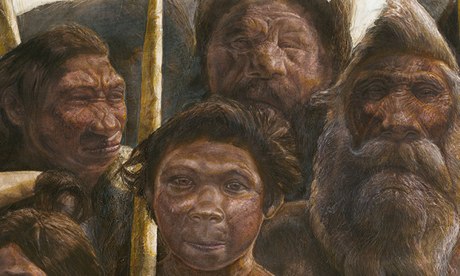7th April 1983
This day in history...Oldest Human Skeleton, aged 80,000 years, discovered in Egypt
Humans have walked this earth for thousands of years. It is always interesting to know what people were like and how they looked all those years ago, which is why archaeology is such a fascinating hobby/career and source of discovery. Today's event is slightly dated now as a few other skeleton's have been found to be a lot older, but it is a good starting point for today's blog.
 |
| Image retrieved from The Guardian. Will remove at owner's request. An artist's impression of the Sima de los Huesos early humans |
80,000 years old: Dr. Fred Wendorf of Southern Methodist University of Dallas, Texas, accidentally discovered the skeleton while working near the Aswan Dam, Egypt. Wendorf estimated that the skeleton was aged between 60,000 and 80,000 years old, based on dating the surrounding rock. Wendorf and his colleagues were exploring the area when they started to find stone tools, similar to those discovered with Neanderthal skeletons in other countries. Whilst examining the rock, Wendorf said that he noticed parts of a human skull and vertebrae in stone that was being eroded away. He realised he had found a grave. The body was apparently found buried face down, with legs tightly flexed and drawn up underneath, with the arms extended to the side.
 |
| Image retrieved from Google. Will remove at owner's request. Archaeological site in Egypt |
The Oldest Human remains: In the 1970s 'The Pit of Bones' or 'Sima de los Huesos', was found in Northern Spain and has been a legendary Spanish archaeological site ever since, providing clues into the history of the human species. Accessing Sima de los Huesos in a difficult venture. Scientists must crawl for hundreds of metres through narrow cave tunnels and rope down through the dark. The early remains that have been found have been painstakingly excavated and pieced together over the last 2 decades and have given the remains of at least 28 ancient people.
 |
| Image retrieved from the BBC. Will remove at owner's request. Scientists inside the Sima de los Huesos |
In 2013 the remains of a 400,000 year old skeleton were found in Sima de los Huesos. Researchers tested and read the DNA from the thigh bone of an early ancestor. The DNA cells were badly degraded and were the hardest samples to work on. The results revealed that the DNA did not match that of the Neanderthals, which were believed and expected to be in that area. Instead the analysis showed that the remains were closer to the sister group called Denisovans that lived in Siberia. This is puzzling to scientists as it could reshape their understanding of our ancestors. It could mean that that the Neanderthals and Denisovans interbred, or could mean that the new remains are a completely separate group. Lots of detailed research is going into the discovery and it may be many years before we can decipher what type of human species the remains actually represent.
 |
| Image retrieved from The Guardian. Will remove at owner's request. The skeleton found in Spain |
I could go into the scientific details and analysis but I don't understand much of it and it gives you a chance to go and do some further research :)
Check out the following for more information
What are your thoughts on this? Leave your comments below
And don't forget to follow @Ydaysnews for more historical events each day!
This, I believe, is the biblical Abel that was slain by his brother Cain: "And Cain talked with Abel his brother: and it came to pass, when they were in the field, that Cain rose up against Abel his brother, and slew him." The technology of the day was sufficient for Cain to have murdered his brother with a type of plow head or perhaps a large rock.
ReplyDeletehttps://www.biblegateway.com/passage/?search=Genesis+4&version=KJV